How Does Transhield Perform in High Winds?
Performance
Transporting products and machinery over the road, protected with tarps, shrink wrap, and other covers, presents a significant challenge when traveling through areas with high wind speeds. Packaging can fail due to crosswinds, wind tunneling blowing it off, or excessive movement underneath the packaging that leads to tearing or snagging.
With over 30 years of designing custom-fit covers for transportation and storage, we understand the challenges of engineering a cover that can withstand the rigors of transportation on exposed flatbed trailers, especially against wind.
Putting Transhield to the Test Against High Winds
In late 2020, at the request of a client, we conducted a series of three separate field tests to evaluate the performance of Transhield covers in dynamic wind, sand, and water conditions. The tests were performed on three separate pieces of HVAC equipment, assessing Transhield covers’ resilience against wind speeds of up to 100 mph, in accordance with modified AAMA 501.1 testing methods. These month-long tests took place at a facility in York, PA, conducted by a third-party testing company. Below is a summary of the testing methods and results from one of the three dynamic wind tests conducted, each set up similarly and yielding consistent results:
Test Method
Our custom-fit covers were evaluated in general accordance with the following: Modified AAMA 501.1-17, Standard Test Method for Water Penetration of Windows, Curtain Walls and Doors using Dynamic Pressure.
Test Procedure
Dynamic wind testing started at 30 – 100 mph increasing in increments of 10 – 20 mph. Each wind load was held for 10 minutes each and ramped up to the next wind speed in succession. The fan was positioned at five different angles/directions facing the test cover. The wind generator was placed 4′ from the test cab rear on the right side at a 30° pitch toward the test trailer for angles #1 and #5. The test trailer was placed 12′ behind the test cab for angles #1 and #5. The wind generator was placed 4′ from the test trailer with no pitch for angles #2, #3, and #4. These various angles mimic crosswinds that a piece of equipment could be exposed to on the back of a flatbed trailer.
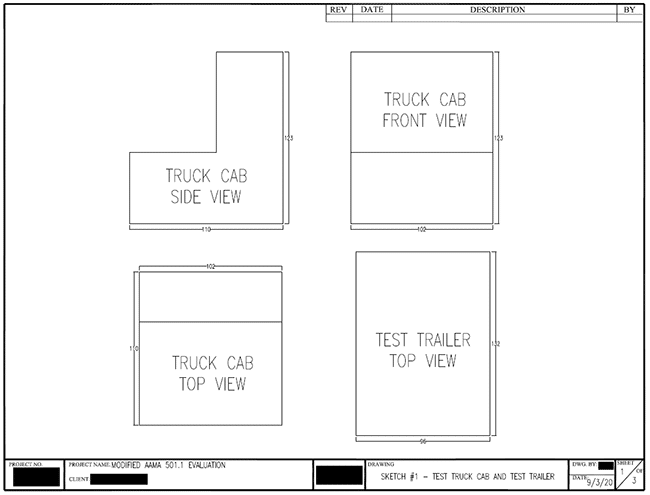
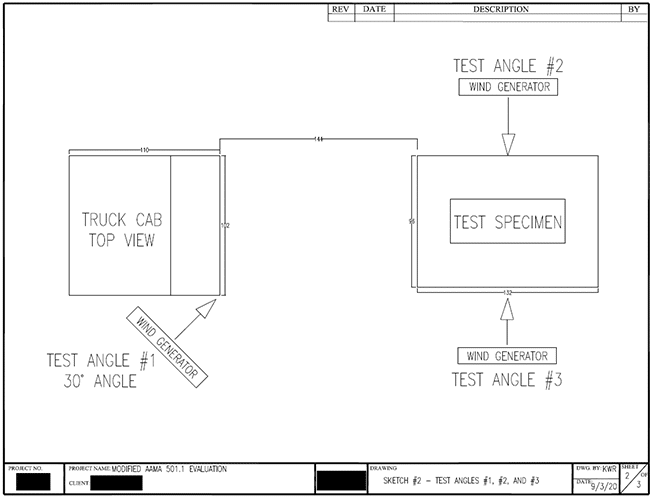
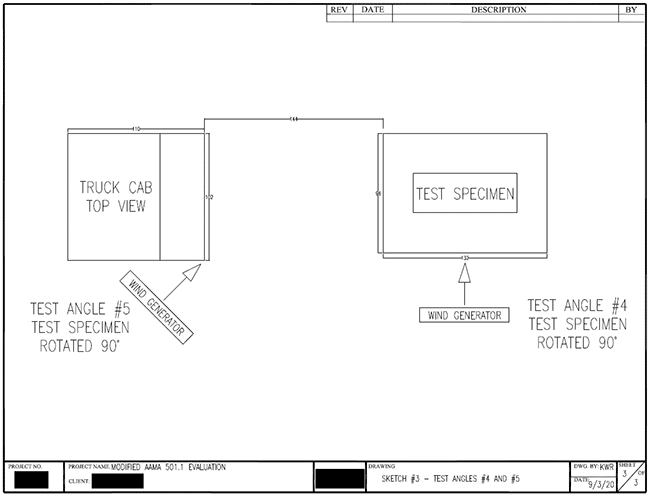
Test Cab Construction
The test cab measured 110″ wide by 123″ high by 102″ deep. The test cab was constructed from nominal 2×4 lumber spaced 16″ on center secured at each end with #8 x 3″ flat head screws. The test cab was sheathed using nominal 1/2″ plywood and was secured using #8 x 1-5/8″ flat head screws.
Test Trailer Construction
The test trailer measured 96″ wide by 132″ long. The test trailer was constructed from nominal 2×4 lumber spaced 16″ on center secured at each end with #8 x 3″ flat head screws. The test trailer was sheathed using nominal 1/2″ plywood and was secured using #8 x 1-5/8″ flat head screws. Four 4″ by 4″ steel angles were secured to the test deck using four #12 x 2-1/2″ flat head screws. The steel angles were used to secure the HVAC equipment to the deck with ratchet straps.
Test HVAC Equipment: Air Handler
The piece of protected HVAC equipment was an air handler consisting of a steel frame without any electronics or components installed. The unit was secured to the shipping pallet using four 5/16″ x 3″ hex head screws, one per corner.
| Width: Millimeters | Inches | Height: Millimeters | Inches | Depth: Millimeters | Inches | |
|---|---|---|---|---|---|---|
| Overall Size | 2219 | 87 3/8 | 3061 | 120 1/2 | 664 | 26 1/8 |
Air Handler Cover
The protective cover for the air handler was constructed from Transhield’s 5-10 mil Shrinkable Fabric®. The edges of the cover utilized tape with a reinforcing scrim. The seams in the field were folded 1/2″ wide on the exterior and a single row of stitching was sewn along the entire seam. The base edge of the cover was folded 1-7/8″ wide to the interior with a single row of stitching along the entire base edge leaving an 18″ wide space at midspan of the cover. A polyester strap measuring 1″ wide by 0.036″ thick was placed in the fold of the base edge. The 18″ spacing was reinforced with a 6″ wide layer of the cover material that was single stitched along the perimeter of the material. Two ratchets were sewn in at the center of the spacing. The cover was placed over the air handler and the ratchet straps were tightened down. The cover was then heat shrunk using a heat tool until it was tight against the air handler. A row of polyethylene tape was utilized to secure the cover base to the air handler base. The tape was also used to patch any defects or stress points after the cover was in place.
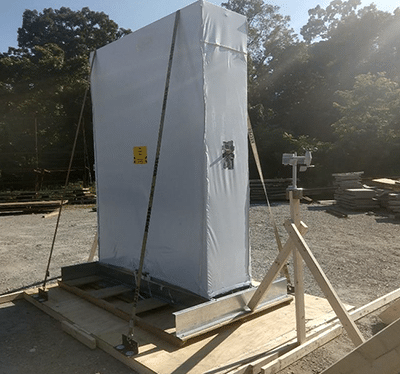
Dynamic Wind Test Results
Below are the results from one of the three dynamic wind tests conducted. To put these wind speeds in perspective, the National Weather Service classifies wind speeds greater than 58 mph as an extreme wind threat level, posing a threat to life and property. It’s important to note that at wind speeds nearing 50 mph, most truck drivers will have ceased traveling until the winds subside.
The temperature during testing was 22° – 33°C (71° – 91°F). The results are tabulated as follows:
| Wind Speed (mph) | Duration(minutes) | Observation |
|---|---|---|
| 30 | 10 | No damage observed |
| 40 | 10 | No damage observed |
| 60 | 10 | No damage observed |
| 80 | 10 | No damage observed |
| 100 | 10 | No damage observed |
| * Wind generator was placed 4′ in front of the cab without any pitch and the trailer distance was 8’ from the cab. | ||
| Wind Speed (mph) | Duration(minutes) | Observation |
|---|---|---|
| 30 | 10 | No damage observed |
| 40 | 10 | No damage observed |
| 60 | 10 | No damage observed |
| 80 | 10 | No damage observed |
| 100 | 10 | No damage observed |
| Wind Speed (mph) | Duration(minutes) | Observation |
|---|---|---|
| 30 | 10 | No damage observed |
| 40 | 10 | No damage observed |
| 60 | 10 | No damage observed |
| 80 | 10 | No damage observed |
| 100 | 10 | No damage observed |
| Wind Speed (mph) | Duration(minutes) | Observation |
|---|---|---|
| 30 | 10 | No damage observed |
| 40 | 10 | No damage observed |
| 60 | 10 | No damage observed |
| 80 | 10 | No damage observed |
| 100 | 10 | No damage observed |
| Wind Speed (mph) | Duration(minutes) | Observation |
|---|---|---|
| 30 | 10 | No damage observed |
| 40 | 10 | No damage observed |
| 60 | 10 | No damage observed |
| 80 | 10 | No damage observed |
| 100 | 10 | No damage observed |
| ** Wind generator was placed 4′ in front of the cab without any pitch and the trailer distance was moved 12’ from the cab. | ||
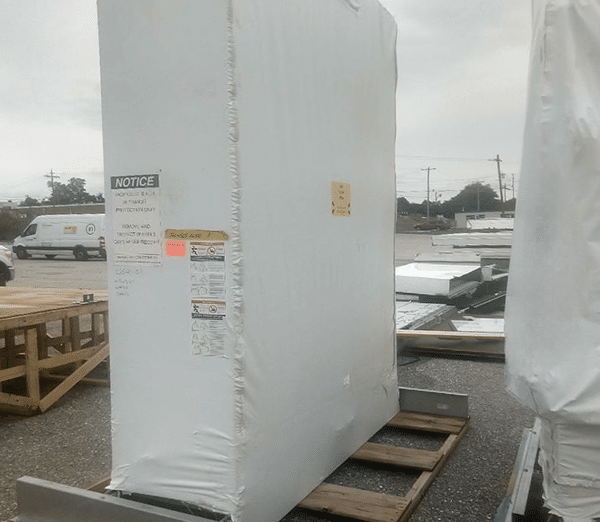
Conclusion
These 2020 field tests demonstrate the resilience of Transhield covers against wind speeds up to 100 mph. These month-long tests, performed by a third-party facility using modified AAMA 501.1 methods, highlight the superior performance of Transhield covers in high wind scenarios. For equipment manufacturers seeking reliable protection for their equipment assets during transport and storage, choosing Transhield offers proven protection and peace of mind. If you’re interested in the best ways to secure your packaging for over-the-road transit and ensure it doesn’t fail due to high winds, be sure to read our guide on preventing cover failures during high-speed transit.
Interested in a custom-fit cover that will elevate your operations and equipment protection process? Contact us today.


